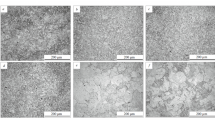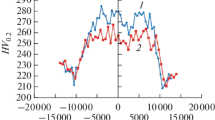We present the results of experimental investigations of the structural-phase state and mechanical properties of welded joints of AISI 321 austenitic steel from thin-walled transformable-volume structures (TVS) of spacecraft application. We estimate the contributions of the phase composition, grain, subgrain, and dislocation structures to the changes in the strength characteristics and the level of local internal stresses in the metal of joints for different conditions of pulse microplasma welding. The optimal technological conditions providing the required mechanical properties of welded structures of the TVS are established.





Similar content being viewed by others
References
B. E. Paton, L. M. Lobanov, and V. S. Volkov, “Metal transformable-volume structures for space engineering,” Acta Astronaut., 110, 50–57. (2015).
L. M. Lobanov, V. S. Volkov, A. V. Yakimkin, V. V. Savitsky, “Functional characteristics improvement of metal transformablevolume structures for space applications,” J. Aerosp. Technol. Manag., 8, No. 1, 55–62 (2016).
B. E. Paton, V. S. Gvozdetskii, D. A. Dudko, et al., Microplasma Welding [in Russian], Naukova Dumka, Kiev (1979).
K. S. Prasad, C. S. Rao, and D. N. Rao, “Study on weld quality characteristics of microplasma arc welded austenitic stainless steels,” Procedia. Eng., 97, 752–757 (2014).
E. Zasimchuk, L. Markashova, O. Baskova, T. Turchak, N. Chausov, V. Hutsaylyuk, and V. Berezin, “Influence of combined loading on microstructure and properties of aluminum alloy 2024-T3,” J. Mater. Eng. Perform., 22, No. 11, 3421–3429 (2013).
L. I. Markashova and O. S. Kushnareva, “Effect of structure on the mechanical properties of the metal of welded joints of aluminum alloys of the Al–Cu–Li system,” Mater. Sci., 49, No. 5, 681–687 (2014).
M. I. Gol’dshtein, V. S. Litvinov, and B. M. Bronfin, Physical Metallurgy of High-Strength Alloys [in Russian], Metallurgiya, Moscow (1986).
H. Konrad, “Work-hardening model for the effect of grain size on the flow stress of metals,” in: Superfine Grain in Metals [Russian translation], Metallurgiya, Moscow (1973), pp. 206–219.
N. J. Petch, “The cleavage strength of polycrystals,” J. Iron Steel Inst., 173, No. 1, 25–28 (1953).
E. Orowan, Dislocations in Metals, AIME, New York (1954).
L. I. Markashova, S. V. Akhonin, G. M. Grigorenko, et al., “Welded joints of refractory titanium alloys doped with silicon. Structure, strength, and crack resistance,” Avtomat. Svarka, No. 11, 7–17 (2012).
Author information
Authors and Affiliations
Corresponding author
Additional information
Translated from Fizyko-Khimichna Mekhanika Materialiv, Vol. 52, No. 2, pp. 48–53, March–April, 2016.
Rights and permissions
About this article
Cite this article
Markashova, L.I., Volkov, V.S. & Kushnareva, O.S. Structure and Physicomechanical Properties of Welded Joints of AISI 321 Steel. Mater Sci 52, 194–199 (2016). https://doi.org/10.1007/s11003-016-9943-z
Received:
Published:
Issue Date:
DOI: https://doi.org/10.1007/s11003-016-9943-z




